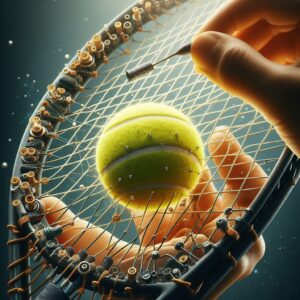Introduction:
In the ever-evolving world of tennis, advancements in equipment and technology have played a pivotal role in shaping the game. From the humble beginnings of wooden rackets to the cutting-edge innovations of modern-day composites, the evolution of tennis gear has revolutionized the sport, influencing playing styles, strategies, and the overall spectator experience. In this article, we journey through time to explore the fascinating evolution of tennis equipment and technology, examining its historical roots, impact on gameplay, controversies, and future trends.
Historical Overview: From Wooden Rackets to Modern Composites:

The journey of tennis equipment traces back centuries, from the rudimentary wooden rackets of yesteryear to the sleek, high-tech composites of today. Early tennis pioneers wielded cumbersome rackets with small heads and gut strings, offering minimal power and control. However, as materials science advanced, manufacturers began experimenting with graphite, carbon fiber, and other lightweight materials, resulting in rackets that are not only more powerful and durable but also customizable to suit individual playing styles.
Impact of String Technology on Spin and Power:
One of the most significant advancements in tennis technology has been the development of string technology, which has revolutionized how players generate spin and power on the ball. Modern strings, made from polyester and multifilament synthetic fibers, offer superior durability and elasticity, allowing players to impart more spin on their shots while maintaining control and consistency. This has led to a shift in playing styles, with players like Rafael Nadal and Novak Djokovic utilizing heavy topspin to dictate play from the baseline.

Court Surfaces and Their Effect on Playing Styles:
In addition to equipment, the playing surface plays a crucial role in shaping the dynamics of tennis matches. From the fast, low-bouncing grass courts of Wimbledon to the slow, high-bouncing clay courts of Roland Garros, each surface presents its challenges and opportunities for players. As a result, players often tailor their playing styles to suit specific surfaces, with serve-and-volley specialists thriving on grass and baseline sluggers excelling on clay.
Controversies Surrounding Equipment Regulations:
Despite the many benefits of technological advancements in tennis equipment, disputes have arisen surrounding equipment regulations and their potential impact on the integrity of the sport. Concerns have been raised about the increasing power and spin generated by modern rackets, leading governing bodies like the International Tennis Federation (ITF) to implement stricter regulations on racket specifications. Additionally, advanced string technology has prompted discussions about limiting string tension and composition to maintain a level playing field.

Future Trends: Innovations in Tennis Gear and Equipment:
The future of tennis equipment promises to be filled with exciting innovations and breakthroughs. The possibilities are endless, from intelligent rackets equipped with sensors to analyze player performance in real-time to advancements in materials science that could yield even lighter, more powerful rackets. Moreover, with an increasing focus on sustainability and environmental stewardship, we may see a greater emphasis on eco-friendly materials and manufacturing processes in the design of tennis gear.
Conclusion:
As we reflect on the evolution of tennis equipment and technology, one thing becomes clear: innovation is the lifeblood of the sport, driving progress and pushing the boundaries of what is possible on the court. Each advancement represents a step forward in the quest for excellence in tennis, from wooden rackets to modern composites, from gut strings to polyester blends. As we eagerly anticipate the next wave of innovations, one thing remains certain: the future of tennis is bound to be as exciting and dynamic as its storied past.
